ASUS ML248H: Thin for the Win?
by Chris Heinonen on October 27, 2011 12:00 AM ESTBrightness and Contrast
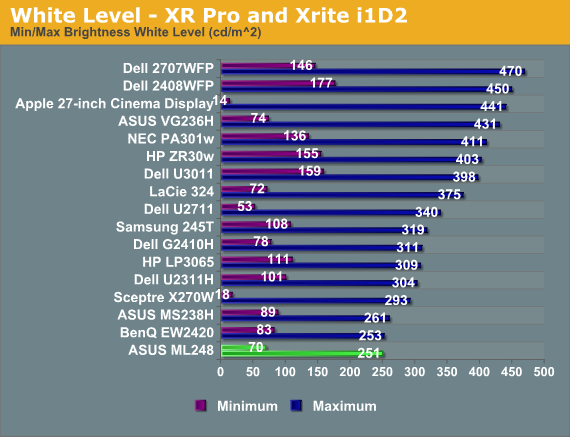
Even with contrast and brightness increased to their maximum values, the ASUS is not a light canon at all. The most I could get out of it was 251 nits, though that is brighter than I would ever use it. When at the minimum brightness level, the ASUS produces 70 nits of light output, which is a bit dim.
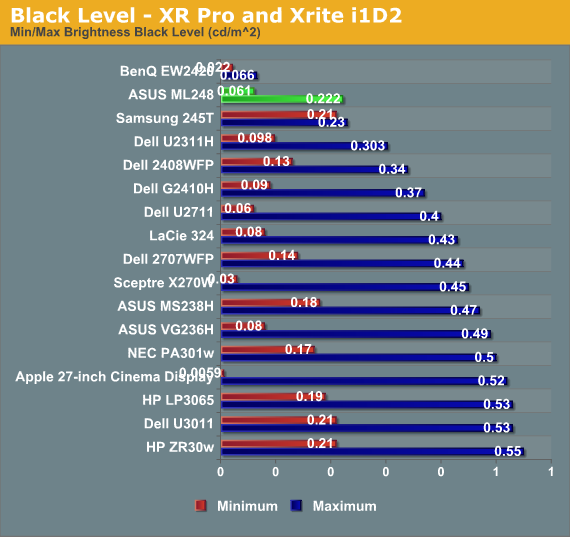
With the brightness back to maximum, the black level only registers at 0.222 nits, whereas with the backlight at minimum we got a black level reading of 0.061 nits.
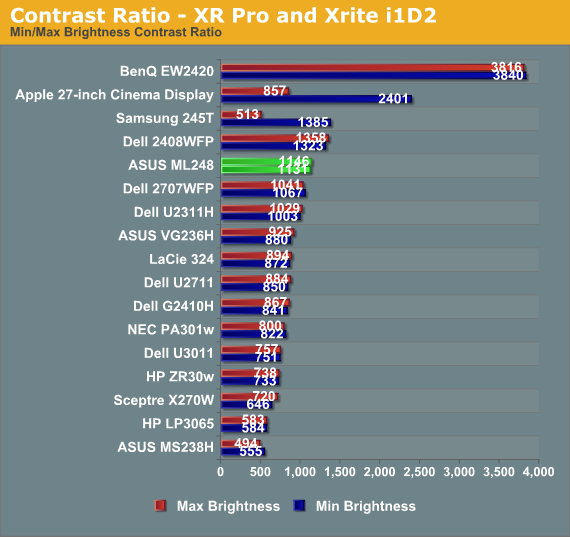
Looking at these in combination, the ASUS is producing contrast ratios of 1131:1 and 1146:1. It looks like whatever brightness level you want to set should work for you with the ASUS, and you can likely expect a contrast ratio of just over 1000:1 as well.
Brightness Uniformity
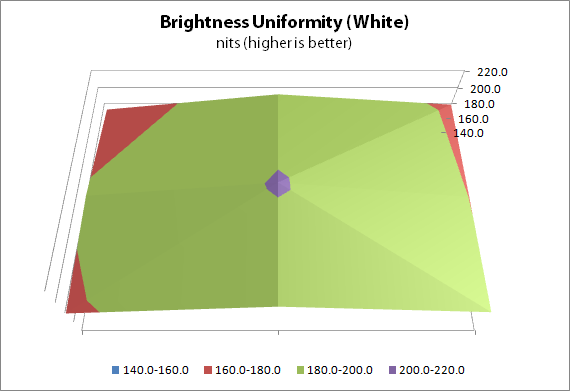
We saw earlier that the color uniformity of the ASUS was not up to par, so I wasn’t sure how the brightness and contrast would be in similar testing. With the center of the screen calibrated to 200 nits on a white screen, the ASUS is around 190 nits at the top and bottom of the center of the screen, but closer to 180 nits at the edges.
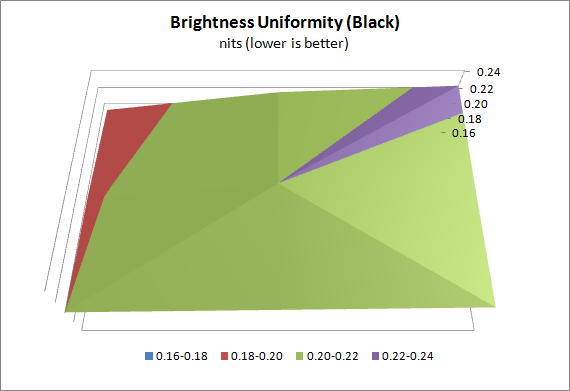
With an all black screen, the ML248H measures 0.22 nits in the center and drops slightly to 0.19 or 0.20 on the edge. These are very small differences, though, and are well within the margin of error for a dark reading from the light meter we use for testing.
I’m not certain what the LED alignment is for the ASUS ML248H, and they haven’t responded to my questions, but I’d guess that however the diffuser is set up for the lights is causing them to have an uneven light distribution across the whole screen, perhaps by having the LEDs themselves centered at the top and bottom of the screen. In any case, this non-uniformity could also be causing the color shifts in our dE uniformity testing. The panel is probably being driven exactly the same at the edges, but the spectrum of light passing through it is different, causing these issues.
I’m not sure if ASUS can fix this by using a different diffuser, or LEDs around the whole edge of the screen, or they might have to go to an LED backlit model to fix it. As I also review home theater displays, LG has recently introduced their Nano LED backlit sets for the home, which keep the slim form factor but provide all the backlit LED benefits like better contrast ratios and more even lighting, so perhaps we will see those in a desktop LCD soon.










57 Comments
View All Comments
Exodite - Thursday, October 27, 2011 - link
I believe you may have misinterpreted my one-word reply.I don't particularly see the need for a new article title, I'm merely confirming my agreement with rsgeiger regarding the horrendous bezel on the display in question.
There's no saving grace for that IMO, my apologies to ASUS.
JarredWalton - Friday, October 28, 2011 - link
It was a response to this thread in particular, not you Exodite. :-)ProDigit - Friday, October 28, 2011 - link
then you should have posted a thread, instead of posted a reply.It seems people on anand are eager to reply on the first comment, so their reply will stay on the first page.. I've noticed so far...
rsgeiger - Monday, October 31, 2011 - link
Point taken Jarred. I guess my interpretation of the title, even with with the question mark, just triggered a reaction in me about the market and where it is headed. I have no issues in general with your writing or choice of title (most times :-)On another note, I didn't expect to get so many responses. I'm glad my taste is shared by others.
Zap - Thursday, October 27, 2011 - link
I also agree. Ugly bezel. The bezel is what you see when you are actually using the monitor, so it should be unobtrusive. Don't make the bezel "fancy" and don't use it for advertising space. If you want to go fancy with "thin," then make a thin bezel. Want to see something impressive? Samsung has big screen HDTVs with ultra thin bezels. I think they are marketing it as less than a quarter inch. On a huge 46-65" screen (the size range they make) how big will that bezel look from your couch? Now THAT is what I call impressive!http://www.samsung.com/us/topic/ultra-slim-bezel-t...
NCM - Thursday, October 27, 2011 - link
And while we're on the subject of aesthetics, I take issue with the article's claim that the rear appearance doesn't matter. In our office the rear of virtually every display is visible, and other than the Apple displays they all look like butt—appropriately, you might say. (Of course this Asus monitor pretty much looks like butt from any angle.)Is a little attention to wire management and a clean appearance on the back really so much to ask?
ProDigit - Friday, October 28, 2011 - link
Strange butt you have, besides, I don't care about the back of a monitor. I'm not the one looking at it. If you don't like it, then throw a towel over it.Valitri - Thursday, October 27, 2011 - link
Everyone is so negative about TN panels. How many of you actually use IPS screens? Do you use these for gaming, how is it?I currently use, admittidely only a mediocre, Samsung P2770 27" TN monitor with a 1080p resolution. My next monitor I am considering 120hz to reduce tearing in gaming. I don't believe you can get that in an IPS screen right now. My only experience with an IPS screen is my iPhone 4, which I absolutely love. I am definately more concerned with tearing and input lag (mouse lag) then I am accurate color reproduction and would like to get some face time with an IPS to see how it really compared.
know of fence - Thursday, October 27, 2011 - link
Vsync is the procedure/setting that removes horizontal screen tearing. It has been explained here on Anandtech many a time.http://www.anandtech.com/show/2794/2
My guess is that 120Hz screens exist mainly for (shutter glasses) 3d support, because at 60 Hz it causes headaches.
JarredWalton - Thursday, October 27, 2011 - link
That's true, but running at 120Hz does tend to reduce the perception of image tearing because the display is refreshing so quickly.